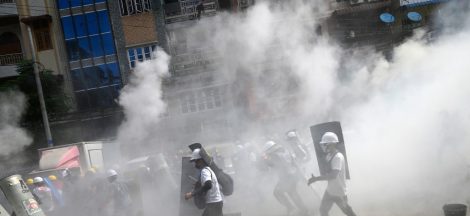Lack of support from regions may shatter electrification program. The government has criticized its regional counterparts for not supporting the national electrification program in terms of funding as the state budget is insufficient to ensure an electricity supply to all parts of Indonesia.

Only five out of 34 provinces have been participating in the program, which requires regional administrations to help with the cost of electricity connection installation.
The five provinces are North Sumatra, West Sumatra, Gorontalo, Central Java and Banten. Administrations in those provinces have committed to provide the funds to 22,992 households in their regions.
Energy and Mineral Resources Minister Ignasius Jonan said that funds from the central government and state electricity firm PLN were not enough to subsidize the initial cost of electricity connection that could reach Rp500,000 (US$35.10) each.
“Many people are unable to pay Rp500,000 [for the installation]. So, we urge regional administrations to set aside some of their budget for the installation cost,” he said in Jakarta recently.
The government has earmarked Rp6 trillion in the state budget to cover the cost of installation for electricity connection this year.
There are still more than 1 million households across Indonesia without an electricity supply.
This year, the Energy and Mineral Resources Ministry targeted 992,841 households in the 450 volt-ampere (VA) category to be freed from the cost of installing an electricity connection. However, only 16.8 percent of them would be fully funded by provincial administrations, the state budget, PLN and the State-Owned Enterprises Ministry.
“[Funds] from PLN’s corporate social responsibility [program] will cover 40,000 households, while a number of SOEs cooperate to cover 103,000 households,” said Rida Mulyana, the ministry’s director general of electricity, at a separate event.
Such a problem is feared to affect the government’s target of 99.9 percent electrification by the end of this year.
As of December 2018, the electrification ratio, which includes the installation of small solar-powered energy saving lamps (LTSHE), had reached 98.3 percent.
By the end of last year, 252,340 out of 68.08 million households in Indonesia had received fund assistance for LTSHE.
There are only 20 provinces with an electrification ratio exceeding 95 percent. The remaining 14 provinces have a ratio less than that, with East Nusa Tenggara (NTT) being the province with the lowest ratio at only 62 percent.
Rida of the ministry explained that the low electrification ratio in NTT was due to its archipelagic characteristics and the hilly contour that makes establishing electricity towers more costly.
“The high cost to erect electricity towers and limited access slow down our efforts in NTT. That’s why we need provincial administrations to help transport the equipment for the infrastructure,” he said.
Surprisingly, East Java, which houses a lot of giant coal-fired power plants (PLTUs), including Paiton Swasta I and II with a total capacity of 2.5 gigawatts (GW), only has an electrification ratio of 94 percent.
This was because while electricity infrastructure in East Java was already adequate, Rida said, people in the province still had low purchasing power.
Djoko Rahardjo Abumanan, PLN regional business director for the eastern part of Java, Bali and Nusa Tenggara, acknowledged East Java’s situation, saying there were still 230 million households in his region that still had no electricity connection.
“We have yet to obtain the funds [to provide free electricity installation] in East Java; we’re still seeking the sources [of funding],” he said. “The [administration of the] province doesn’t fund the program; they instead ask [the central government] for help.”
Minister Jonan expected that fund assistance from regional administrations would help the government to achieve its 99.9 percent electrification ratio target by the end of this year.
He claimed that households would be able to pay for the monthly electricity bill at around Rp 15,000 as the main problem was only about limited funds for connection installation.
“So, the regency, city and provincial administrations should help cover [the installation cost],” Jonan said as quoted by kompas.com recently.
The government’s move to push regional administrations to help with the cost was not wrong, but rather short-term in nature, said Fabby Tumiwa, executive director of local energy watchdog Institute for Essential Services Reform (IESR).
Fabby said the government should find a long-term and better solution to achieve the goal, such as building small-grid power plants in remote villages.
“Connecting electricity from PLN’s grids is too costly for remote and poor villages. It is better if the government develops small-scale and renewable energy power plants,” he said, adding that regional budgets were too limited to provide free electricity installation.
He further suggested that the government provide a blueprint on how customers use electricity to support their productive activities rather than just for consumptive ones.
“Having access to electricity means nothing if it cannot improve the people’s standard of living,” he said. Lack of support from regions may shatter electrification program (Stefanno Reinard Sulaiman, The Jakarta Post)





 Kebanyakan Mesin Tekstil Sudah Tua, Bagaimana Kita Masuk ke Industry 4.0?
Kebanyakan Mesin Tekstil Sudah Tua, Bagaimana Kita Masuk ke Industry 4.0? 